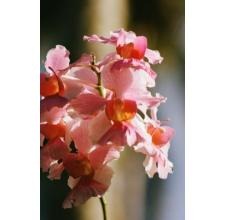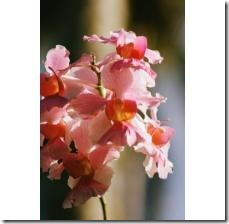Orchids are tall and spindly, with delicate blossoms that come in a variety of colors. They’re especially well-suited to indoor growing due to their low light needs, according to Clemson University Cooperative Extension’s "Orchids" article, prepared by horticulturalists. Cattleya orchids are the most well-known, and Dendrobium orchids are subtly white-and-lavender-colored.
- Difficulty:
- Easy
Instructions
things you’ll need:
- Pot
- Chopped tree bark or volcanic stone
- Fertilizer
- Plant orchids in pots filled with chopped fir tree bark, tree fern fiber, charcoal, peat, volcanic stone, perlite or a combination. Do not plant them in regular soil. In the wild, orchids are epiphytes that grow on trees and absorb water from them; the orchids in your home or garden need similar conditions.
- Place the plants in a southern window with bright, indirect sunlight, or in a partially shaded outdoor area. When midday sun hits the orchids, shade them with a sheer curtain or cover. If using artificial lighting, low light is best.
- Keep temperatures mild to avoid stressing your orchids. Dendrobium orchids can survive temperatures as low as 52 degrees F at night, but others require a minimum of 60 to 65 degrees F after dark. Warmer temperatures in the day — usually between 70 and 80 degrees F — promote growth. Grow in an area that has 40 to 60 percent humidity all day and night.
- Water the orchids one to two times per week when the soil goes completely dry, and let the water drain out each time. An exception is the Phalaenopsis orchid, which needs watering more frequently when the soil is almost — but not completely — dry. Orchids won’t thrive if forced to sit in soggy soil. In humid conditions, they absorb moisture from the air.
- Apply fertilizer once a month — but only when the orchids are growing. Over-fertilizing is one of D. G. Hessayon’s "Seven Deadly Sins" of orchid care in his book "The Orchid Expert." Most orchids require 20-20-20 fertilizer ratios, but those growing in bark may need more nitrogen, such as the levels found in 30-10-10 or 15-5-5 fertilizer, according to Clemson University Cooperative Extension website.
Tips & Warnings
-
Water in the morning to give foliage a chance to dry before nightfall. This prevents wet-leaf diseases.
-
Keep airflow moving near the plant, but don’t expose it to blasts of wind, such as from opening a door in winter. Balance is crucial.


Deprecated: strpos(): Passing null to parameter #1 ($haystack) of type string is deprecated in /home/agriviek8Qv/agriviet.net/public_html/wp-includes/comment-template.php on line 2522